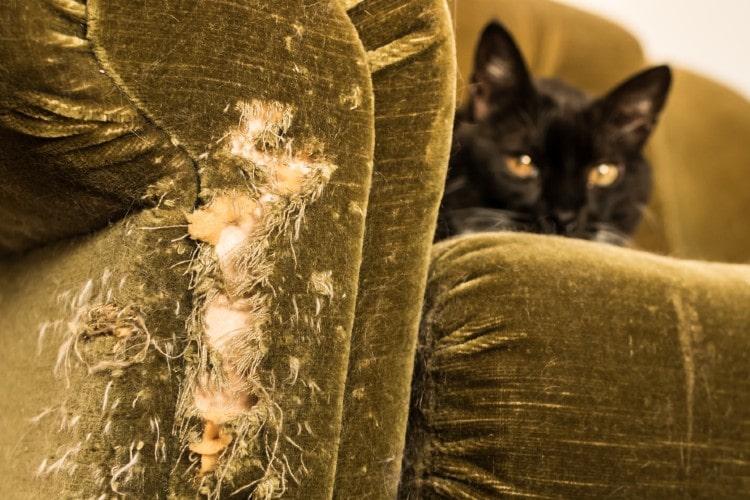Cats are amazing pets and companions, but they can also be rebellious and stubborn. In general, traditional methods of discipline are unlikely to be ineffective, but fortunately there are a number of alternative ways to discipline your cat.
Your cat may exhibit behaviors that you don’t like, and it’s important to know how to deal with these behaviors in a way your cat can understand. Unlike human children, cats cannot reason and traditional methods of disciplining them will most often backfire.
Cats require a different approach to ensure their behavior changes. Depending on the unwanted behavior they’re exhibiting, there are some methods that can successfully be applied to cats, but there are also many things to avoid.
Cat Discipline: How to Positively Impact Behavior
Positive Reinforcement
When trying to dissuade your cat from certain behaviors, for example, getting on the counters, scratching the furniture, or urinating outside of the litter box, it’s essential to remember that cats do not respond well to negative reinforcement.1 Instead, positive reinforcement should be used to reinforce desired behaviors.
Positive reinforcement may include verbal praise, petting, and treats. Cats are very intelligent, and they want to please you. If you reward a cat for a desired behavior, they will want to repeat it, for the positive reinforcement and to please you. If you are careful to pair the positive reinforcement with the desired behavior, you’ll be well on your way to teaching the cat.2
Removal of Attention
Another tactic that works for both cats and dogs, is the removal of attention. Often, cats and dogs may misbehave in an effort to gain your attention, even if it’s negative. Being picked up and removed from the counter, swatted, or yelled at, is still attention to your cat.
Cats very much want to be with you and interact with you, so withdrawing all your attention can be a useful discipline tool.3 This involves ignoring the cat completely when they are exhibiting an unwanted behavior. For example, if you are petting your cat while sitting on the couch and they suddenly nip you, immediately stop petting them, get up, and leave the room.
Redirection
Redirection can also be useful. This involves stopping the undesired behavior by redirecting the cat to a more appropriate behavior.4 For example, if your cat begins scratching the couch, redirect them to their scratching post. It can be helpful to have a post near the area where the unwanted scratching is occurring.
Make Some Changes in the Home
Additionally, look at your household and determine if it is possible to make changes that will reduce unwanted behaviors. If you’re attempting to get your cat to stop jumping onto the kitchen counters, it may be helpful to place a cat perch or tree near the counter that will allow your cat to see what’s going on in the kitchen. Also, remove any food or other temptation from the counter to lessen the desire to jump up there.5
Deterrent methods such as canned air that responds to movement, noise makers with electronic sensors, foil, or sticky tape may also be used to deter unwanted behaviors.6 The keys to these methods are that they must be consistent (set up at all times) and NOT associated with you. This is the reason spray bottles, physical discipline, and yelling are discouraged. Unless you watch your cat 24/7, it’s impossible to be consistent, and the negative reinforcement coming from you is likely to damage the relationship with your cat.
Cat Health and Behavior
Especially in cases of a cat neglecting to use their litter box, your first course of action is a trip to the veterinarian.7 This is also true for behavioral changes. These issues often signal a health issue that must be properly treated by a doctor. Your veterinarian can also help you deal with behavioral issues with enrichment ideas, environmental changes, and if needed, medications.
What Not to Do
Never hit your cat. Cats do not respond to physical discipline, and you’ll only make your cat scared of you. This applies to scruffing, swatting, and any other method of physical punishment.8
You should also not yell at your cat. Though a “misbehaving” cat can be frustrating, cats are not malicious, and they are not trying to misbehave on purpose. Cats cannot understand human language and yelling at them will only confuse and scare them. This often makes the cat more likely to misbehave and may also lead to anxiety issues.9
Additionally, you should not play rough with your cat. This includes rolling them, pinning them down, allowing them to bite or chew on you, and aggressive play. It is best to use a cat toy when playing so that there is a complete distinction between play and your body. Cats that chew or nip you should be immediately redirected to an appropriate toy or have your attention withheld completely to discourage the behavior.10
Spray bottles are discouraged as a method of discipline in cats, despite widespread advice to use them. The cat will fear you which will damage the bond between you and your cat.11 Also, because it is impossible to be present to spray the cat all the time, the spray will not dissuade the behavior.
Final Thoughts
Cats are curious creatures, and it’s necessary to take a different approach when disciplining them. Spending time with your cat, productive play, and praise will be much more effective in curbing unwanted behaviors than traditional methods of discipline. Patience and consistency are key. If you ever feel your cat is not responding, please schedule an appointment with your veterinarian to rule out health issues and to get assistance
Article Sources
Pets Digest uses only high-quality sources, including peer-reviewed studies, to support the facts within our articles. Read our editorial process to learn more about how we fact-check and keep our content accurate, reliable, and trustworthy.
- Hill’s Pet. Reprimanding your cat: suggestions & tips. Hillspet.com. Published January 1, 2018. Accessed August 5, 2022.
- Burns K. Unlock the feline mind (or how to train your cat). Avma.org. Published September 16, 2020. Accessed August 5, 2022.
- Ollila E. Do’s and don’ts for disciplining a cat. Hillspet.com. Published May 7, 2018. Accessed August 5, 2022.
- American Association of Feline Practitioners. 2012 Positive reinforcement of cats. Catvets.com. Accessed August 5, 2022.
- Calder C. Cats and high places: keeping them off counters and tables. Veterinarypartner.vin.com. Published February 17, 2021. Accessed August 5, 2022.
- Placer Society for the Prevention of Cruelty to Animals. Aversives for cats. Placerspca.org. Accessed August 5, 2022.
- American Society for the Prevention of Cruelty to Animals. Litter box problems. Aspca.org. Accessed August 5, 2022.
- Ollila E. Cat training: how to train your cat the easy way. Hillspet.com. Published May 2, 2016. Accessed August 5, 2022.
- Hill’s Pet. How to reprimand your cat. Hillspet.co.uk. Published February 26, 2020. Accessed August 5, 2022.
- Horwitz D, Landsberg G. Preventing and punishing undesirable behavior in cats. Vcahospitals.com. Accessed August 5, 2022.
- Johnson E. Should I spray my cat with water when they misbehave? Betterpet.com. Updated February 23, 2022. Accessed August 5, 2022.


